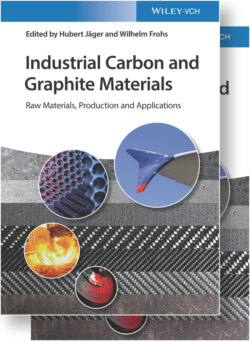Читать книгу Industrial Carbon and Graphite Materials - Группа авторов - Страница 261
6.1.1.1 The Relevance of Raw Materials
ОглавлениеPetroleum coke, coal‐tar pitch (CTP) coke, anthracite, natural graphite, and carbon black are commonly used as raw materials in the production of industrial carbon artifacts. Although CTP is the common binder material for the solid filler material, in some cases, polymer resins and petroleum‐derived pitch are used.
Metallurgical coke from mineral coal or calcined lignite coal are used as packing material in ring furnaces and graphitization furnaces but are not common as raw materials for industrial carbon artifacts themselves due to their high ash content and poor graphitizability or even non‐graphitizability.
The final properties of carbon and graphite products and their performance depend to a large extent on the properties of the raw materials. Therefore, the selection of raw materials is very important in the manufacturing of carbon and graphite artifacts.
Figure 6.1.1.1 Production scheme for synthetic carbon and graphite materials. Source: Courtesy SGL Carbon.
The main raw material sources are petroleum coke (see 6.1.2 petroleum coke) and CTP coke (see 6.1.3 coal‐tar pitch coke) for the solid filler component and CTP as binder (see 6.1.5 tar and pitch). Petroleum coke is maintained as a by‐product during crude oil refining. Coal tar and its derivates (CTP and coal‐tar coke) are by‐products from coal coking (Figure 6.1.1.2). Their availability depends on the trends in the oil and steel industry. Their price as by‐products is less dependent on the crude oil or coal price but on the demand in the market they serve. The rapid growth of China’s economy at the beginning of the twenty‐first century let it become the biggest steel and aluminum producer with more than 50% in both areas. This position has an overwhelming impact on the carbon materials like graphite electrodes, furnace linings, cathodes, and anodes in regard to their demand and pricing.
Figure 6.1.1.2 Sources for petroleum and coal‐tar pitch coke.
Economics of oil refineries and reduced availability of easily accessible fields with crude oil of decent quality have already led to a significant drop in calcined petroleum coke quality for the aluminum industry [1]. With respect to the quantity of sources for raw material, the crude oil production is forecasted to increase in the next 15–20 years, followed by a significant decrease by 2050 [2]. On a long‐term basis, this will have consequences not only for the carbon and graphite industry but also for its main customers, the aluminum and steel industries. Under these circumstances, coal tar, the by‐product from coal coking, may gain importance as an alternative raw material to petroleum residues in the production of the solid coke filler material. However, the coking coal process is itself under significant environmental pressure due to the generation of polyaromatic hydrocarbons (PAHs), which are listed as carcinogenic materials, and its future prospects are somewhat uncertain, particularly in the Western world.
